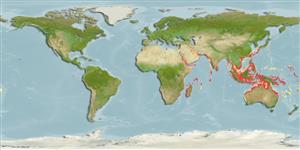>
Beloniformes (Needle fishes) >
Hemiramphidae (Halfbeaks)
Etymology: Rhynchorhamphus: Greek, rhingchos = snout + Greek,rhamphos = bill (Ref. 45335).
Eponymy: Georges Dussumier is described in the etymology as a friend of Valenciennes. [...] (Ref. 128868), visit book page.
More on author: Valenciennes.
Environment: milieu / climate zone / depth range / distribution range
Ecologie
marien; zoet water; brak water; diepte 0 - ? m. Tropical
Indo-West Pacific: the most widespread of the four species of Rhynchorhamphus, found from Persian Gulf through Arabian Sea and Bay of Bengal through the Western Central Pacific north to Taiwan and Hong Kong and east to New Guinea and northern Australia.
Lengte bij maturiteit / Grootte / Gewicht / Leeftijd
Maturity: Lm 15.8, range 15 - 16.5 cm
Max length : 31.0 cm mannelijk / geslacht onbekend; (Ref. 10943)
Dorsale stekels (totaal) : 0; Dorsale zachte stralen (totaal) : 13 - 17; Anale stekels: 0; Anale zachte stralen: 13 - 16; Wervels: 54 - 59. Very strongly pronounced domed upper jaw which is the longest and most arched of the four species of Rhynchorhamphus.
Found in inshore waters (Ref. 75154). Enters freshwaters (Ref 13446).
Levenscyclus en paargedrag
Maturiteit | Voortplanting | Paaien | Eieren | Fecunditeit | Larven
Collette, B.B. and J. Su, 1986. The halfbeaks (Pisces, Beloniformes, Hemiramphidae) of the Far East. Proc. Acad. Nat. Sci. Philadelphia 138(1):250-301. (Ref. 10943)
Status op de Rode Lijst van het IUCN (Ref. 130435: Version 2024-2)
Gevaar voor de mens
Harmless
Gebruik door de mens
Visserij: van minder commercieel belang
Tools
Speciale rapporten
Download XML
Internetbronnen
Estimates based on models
Preferred temperature (Ref.
123201): 24.9 - 29.2, mean 28.3 °C (based on 1440 cells).
Fylogenetische diversiteitsindex (Ref.
82804): PD
50 = 0.5625 [Uniqueness, from 0.5 = low to 2.0 = high].
Bayesian length-weight: a=0.00263 (0.00135 - 0.00511), b=2.95 (2.78 - 3.12), in cm total length, based on LWR estimates for this species & (Sub)family-body (Ref.
93245).
Trofisch niveau (Ref.
69278): 3.1 ±0.2 se; based on size and trophs of closest relatives
Generation time: 0.8 ( na - na) years. Estimated as median ln(3)/K based on 1
growth studies.
Weerstandsvermogen (Ref.
120179): Hoog, minimale populatieverdubbelingstijd minder dan 15 maanden (K>1).
Fishing Vulnerability (Ref.
59153): Low vulnerability (16 of 100).
